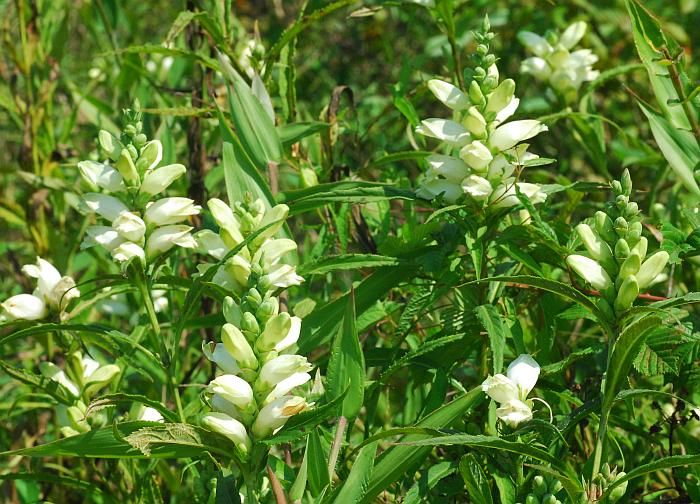Chelone glabra L.
White Turtlehead

Native
CC = 8
CW = -5
MOC = 15
© SRTurner
Chelone glabra L.White Turtlehead | |
 |
Native CC = 8 CW = -5 MOC = 15 |
© SRTurner |
|
Family - Plantaginaceae Habit - Rhizomatous perennial herb. Stems - To 1.5 m, ascending to erect, sometimes sprawling with age, mostly unbranched, glabrous.
Leaves - Opposite, simple, 2-20 cm long, 0.5-3.0 cm wide, sessile to short-petiolate, linear to lanceolate, angled at base, sharply pointed, margins sharply toothed to nearly entire, usually glabrous.
Inflorescence - Dense terminal spikes to 9 cm long, usually subtended by a pair of bracts similar to the stem leaves, these ovate, pointed at tip, 1.5-8.0 cm long. Individual flowers sessile or the uppermost sometimes minutely stalked, each subtended by 2 or 3 prominent, sepaloid bractlets positioned immediately below the calyx, these ovate, 4-10 mm long.
Flowers - Calyces 5-11 mm long, deeply 5-lobed, the lobe margins sometimes thin and translucent, glabrous or minutely short-hairy. Corollas 25-35 mm long, bilabiate, 5-lobed but often appearing more or less 4-lobed, glabrous externally, the tube longer than the lobes, white or pale cream colored, occasionally greenish or pinkish, the lower lip shallowly 3-lobed and bearded with woolly hairs, the upper lip slightly to moderately keeled and arched downward or slightly helmet-shaped, minutely notched to shallowly 2- lobed at the tip. Fertile stamens 4 with anther sacs densely woolly. Staminode 1, green, glabrous. Style 1, not exserted, the stigma capitate, unlobed.
Fruits - Capsules, ovoid or nearly globose, tapered to a sharply pointed or minutely beaked tip, glabrous, the 2 locules equal in size, dehiscent longitudinally along the 2 sutures. Seeds numerous, 3-4 mm long, broadly oval to more or less circular in outline, strongly flattened, the body brown to dark brown, usually only on 1 of the surfaces, encircled by a broad wing, this tan to light brown, the surface otherwise glabrous, more or less smooth. Flowering - July - October. Habitat - Fens, streambanks, bottomland forests. Origin - Native to the U.S. Lookalikes - None close. Other info. - This striking species can be found in a few scattered counties in Missouri, mostly in the southeast, but is generally uncommon in the state. Its U.S. distribution is confined to the eastern half of the country, and is predominantly northern. When in flower it is relatively easy to recognize by habitat and its unique flowers. The plant grows well from seed and would do well in in cultivation as a pond margin plant. Photographs taken at Mountain Longleaf National Wildlife Refuge, AL., 10-2-05 (DETenaglia); also at Shaw Nature Reserve, Franklin County, MO, 9-2-2015, and Cruise Mill fen, Washington County, MO, 9-24-2018 (SRTurner). |